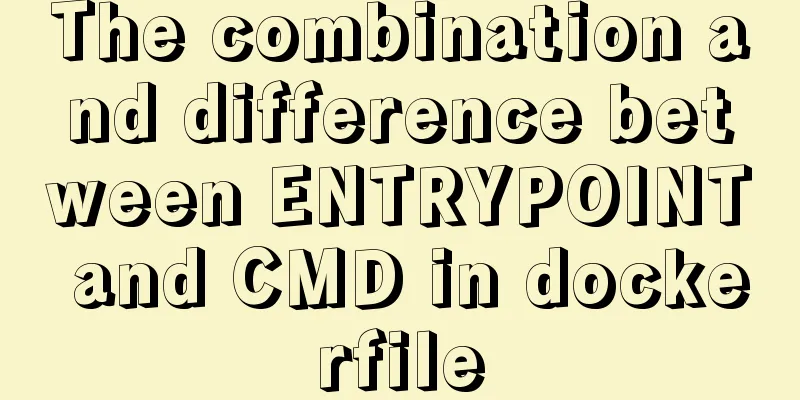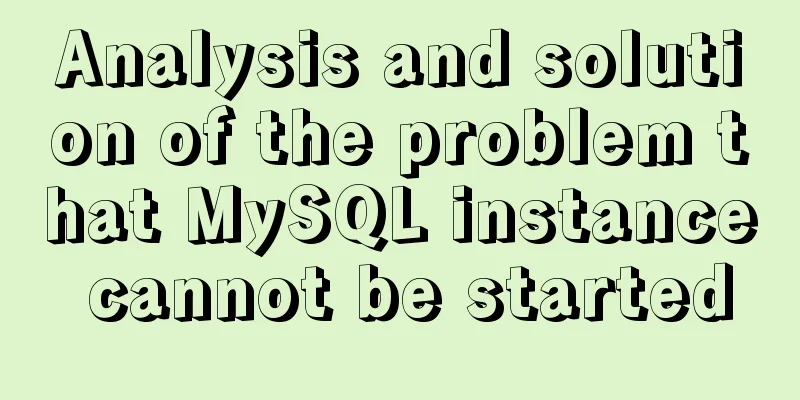The combination and difference between ENTRYPOINT and CMD in dockerfile

|
In the previous article [Detailed explanation of dockerfile for docker container], we have a more comprehensive understanding of dockerfile. We also mentioned that both `ENTRYPOINT` and `CMD` can specify the container startup command. Because these two commands are the core of mastering Dockerfile writing, they are discussed separately here.
1. Write in front In the previous article, we have a comprehensive understanding of dockerfile. We also mentioned that 2. The main difference between CMD and ENTRYPOINTLet's get straight to the point. Both CMD and ENTRYPOINT are used to specify the command to start the container execution. The difference is:
In order for the built container to start normally, the Dockerfile file we write must contain a CMD or ENTRYPOINT instruction. 3. Combination of CMD and ENTRYPOINT1.CMD
When the Dockerfile contains multiple CMDs, only the last one is loaded and used. We search for the centos official image in dockerhub and take a look at the official dockerfile file.
Basically, each official image will provide us with the Dockerfile link of their own version, as follows:
Let's look at the Dockerfile of the FROM scratch ADD centos-8-x86_64.tar.xz / LABEL org.label-schema.schema-version="1.0" org.label-schema.name="CentOS Base Image" org.label-schema.vendor="CentOS" org.label-schema.license="GPLv2" org.label-schema.build-date="20201204" CMD ["/bin/bash"] There are only four lines, which is all the content of the Dockerfile to build a Not only centos, but other debian, ubuntu, busybox and other images only need to specify the startup command through CMD. For example, busybox is more concise: FROM scratch ADD busybox.tar.xz / CMD ["sh"] To build this kind of basic and tool images, we only need to specify a necessary CMD to start the container. But we don't write a Dockerfile just to start a container. Most of the time we want to run our app and service in the container. Of course, it can also be started through CMD, but there is a flaw in this. The CMD startup command we mentioned above will be replaced by the docker run parameter. We have the following Dockerfile [root@localhost dockerfiles]# cat Dockerfile FROM centos CMD ["/bin/top","-b"] After building, start the container with the parameter ps.
[root@localhost dockerfiles]# docker run -it centos_top:v1 ps
PID TTY TIME CMD
1 pts/0 00:00:00 ps You can see that after starting the container, 2. ENTRYPOINT combined with CMD
As mentioned above We take the official nginx dockerfile latest version 1.21 as an example
First, let's look at ... COPY docker-entrypoint.sh / COPY 10-listen-on-ipv6-by-default.sh /docker-entrypoint.d COPY 20-envsubst-on-templates.sh /docker-entrypoint.d COPY 30-tune-worker-processes.sh /docker-entrypoint.d ENTRYPOINT ["/docker-entrypoint.sh"] EXPOSE 80 STOPSIGNAL SIGQUIT CMD ["nginx", "-g", "daemon off;"] From the above we can see that when starting the nginx container, the #docker-entrypoint.sh nginx -g "daemon off;" What happens when we pass in parameters using docker run? I passed in nginx-debug #docker run -dt nginx nginx-debug -g "daemon off;" At this time, starting the container is equivalent to executing the following script and parameters #docker-entrypoint.sh nginx-debug -g "daemon off;" Let's take a look at the container we started through ps [root@localhost dockerfiles]# ps -ef|grep nginx root 6327 6306 0 Aug12 pts/0 00:00:00 nginx: master process nginx -g daemon off; 101 6384 6327 0 Aug12 pts/0 00:00:00 nginx: worker process 101 6385 6327 0 Aug12 pts/0 00:00:00 nginx: worker process root 16800 16780 3 12:51 pts/0 00:00:00 nginx: master process nginx-debug -g daemon off; 101 16857 16800 0 12:51 pts/0 00:00:00 nginx: worker process 101 16858 16800 0 12:51 pts/0 00:00:00 nginx: worker process Obviously, our two containers with parameters nginx and nginx-debug were started successfully! That is to say, the command we specified through What is docker-entrypoint.sh? docker-entrypoint.sh This is a preprocessing script usually used to filter command line parameters or execute exec to start the process of container 1. Implementing command default parameters or receiving docker run parameters through ENTRYPOINT+CMD is a very popular and useful way to write dockerfile. This is the end of this article about the combination of ENTRYPOINT and CMD in dockerfile. For more information about ENTRYPOINT and CMD in dockerfile, please search for previous articles on 123WORDPRESS.COM or continue to browse the following related articles. I hope you will support 123WORDPRESS.COM in the future! You may also be interested in:
|
<<: Solution for converting to inline styles in CSS (css-inline)
>>: What is a MySQL index? Ask if you don't understand
Recommend
How to install MySQL 8.0 in Docker
Environment: MacOS_Cetalina_10.15.1, Mysql8.0.18,...
Detailed explanation of the difference between tinyint and int in MySQL
Question: What is the difference between int(1) a...
25 advanced uses of JS array reduce that you must know
Preface Reduce is one of the new conventional arr...
Several skills you must know when making web pages
1. z-index is invalid in IE6. In CSS, the z-index...
Some notes on mysql create routine permissions
1. If the user has the create routine permission,...
How to define input type=file style
Why beautify the file control? Just imagine that a...
The ultimate solution for playing background music in Firefox browser (Chrome multi-browser compatible)
The recommended code for playing background music ...
Basic usage details of Vue componentization
Table of contents 1. What is componentization? 2....
Analysis of two usages of the a tag in HTML post request
Two examples of the use of the a tag in HTML post...
A brief discussion on HTML special character encoding CSS3 content: "I am a special symbol"
Some special characters and icons used in the pro...
MySQL optimization: use join instead of subquery
Use JOIN instead of sub-queries MySQL supports SQ...
Teach you how to get the pointer position in javascript
The method of obtaining the position of the point...
How to point the target link of a tag to iframe
Copy code The code is as follows: <iframe id=&...
vue perfectly realizes el-table column width adaptation
Table of contents background Technical Solution S...
Introduction to root directory expansion under Linux system
1. Check Linux disk status df -lh The lsblk comma...













